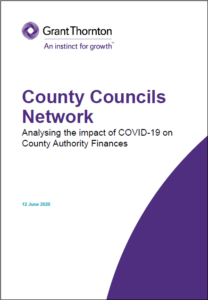
CCN Latest News, CCN News 2020 | 17 June 2020

The study, carried out by leading business and financial adviser Grant Thornton UK LLP, and based on data provided by county and unitary authorities, shows that all 39 of councils included in the study could use up their available reserves in 2021/22 to cover a funding shortfall of £2.5bn. The report sets out that England’s largest councils could be facing the prospect of ‘large scale reductions’ in services to set legal budgets this year.
The report has been covered by the BBC, the Guardian, and the Yorkshire Post.
 It shows that county authorities will be particularly vulnerable to the fiscal impacts of a second wave of Coronavirus later, should this happen later this year, and a further outbreak and lockdown could increase the funding shortfall they face to an estimated £4.5bn over the next two years.
It shows that county authorities will be particularly vulnerable to the fiscal impacts of a second wave of Coronavirus later, should this happen later this year, and a further outbreak and lockdown could increase the funding shortfall they face to an estimated £4.5bn over the next two years.
The County Councils Network (CCN), who commissioned the study, says that the report provides robust evidence to Government on the financial challenges facing local government as a result of the pandemic. CCN says that Ministers are ‘alive’ to the challenges, and they want to work with government to design a ‘comprehensive’ plan to prevent these forecast scenarios becoming a reality.
Using data provided by county and unitary authorities on estimated cost pressures and lost income resulting from the crisis, alongside projections on future revenues and legacy costs, Grant Thornton modelled the potential financial impact across three scenarios stretching to 2025. The analysis showed:
Read a briefing which summarises the report here.
Based on the financial projections, Grant Thornton observe that the projected financial pressures are not sustainable for a significant number of county authorities within their available financial resources, even if measures were taken to reduce costs.
The report states that there is a risk that a significant number of councils will be forced to enact large scale service reductions and, as a last resort, issue a section 114 notice in the current year to meet their statutory duty to deliver a balanced budget in 2020/21 and 2021/22.
The report also suggests that it is necessary for the government to develop further packages of financial support and flexibilities as part of a wider medium-term plan to ensure that councils are adequately funded in the future and to prevent the forecasts on reserves being exhausted becoming a reality.
It suggests that these measures could include further emergency funding to meet the immediate shortfall in funding in 2020/21, and an income guarantee to prevent the accumulation of lost council tax and business rates impacting council sustainability from 2021/22 onwards.
 Cllr Carl Les, finance spokesperson for the County Councils Network and leader of North Yorkshire County Council, said:
Cllr Carl Les, finance spokesperson for the County Councils Network and leader of North Yorkshire County Council, said:
“Councils across the country are grappling with increased cost pressures in adult social care and other core local services, whilst facing huge reductions in income due to the lockdown and the country entering a recession.
“Grant Thornton’s analysis, based on council estimates on costs and their informed assumptions on how additional costs and lost revenue could develop over the short and medium term, show a significant funding gap opening up for county authorities due to the pandemic. This research shows the challenges facing county authorities and the severity of the potential impact on councils’ sustainability and provides important insights to inform government policy.
“Building on this evidence, we want to work with government to develop a comprehensive plan to support councils over the coming months and years. We know ministers are alive to the challenge and hope this report is a valuable contribution to informing future interventions to support all councils.”
Notes to editor
| Scenarios | Funding gap in 2020/21 due to Coronavirus after emergency funding | Funding gap in 2021/22 when lost income in business rates and council tax factored in | Funding Gap 2020/21-2021/22 |
| Scenario 1 | £751.8m | £1,786bn | £2,537bn |
| Scenario 2 | £1,301bn | £2,358bn | £3,659bn |
| Scenario 3 | £1,872bn | £2,664bn | £4,546bn |
| Scenarios* | Cost Pressures & non-tax based lost income 2020/21 after emergency funding | Council tax & business rates from 2021/22 | ‘legacy’ cost pressures 2021/22 |
| Scenario 1 | Full year May Delta return excluding council tax and business rates | · 6% reduction in council tax base due to non-collection
· 10% reduction in retained business rates · 1.99% increase in council tax rate
|
50% of 2020/21 pressures in adult social care, children’s services and non-tax-based lost income |
| Scenario 2 | Extrapolation of 100% of April actual expenditure and lost income (excluding council tax and business rates) from May Delta return and extrapolates this cost for April-July, and 50% of April’s actual expenditure for each of the remaining months for financial year
Additional assumptions made to children’s services and home to school transport |
· 6% reduction in council tax base due to non-collection
· 10% reduction in retained business rates · 1.99% increase in council tax rate
|
50% of 2020/21 pressures in adult social care, children’s services and non-tax-based lost income |
| Scenario 3 | Extrapolation of 100% of April actual expenditure and lost income (excluding council tax and business rates) from May Delta return and extrapolates this cost for April-July, and 75% of April’s actual expenditure for each of the remaining months for financial year
Additional assumptions applied to children’s services and home to school transport |
· 6% reduction in council tax base due to non-collection
· 10% reduction in retained business rates · 1.99% increase in council tax rate
|
50% of 2020/21 pressures in adult social care, children’s services and non-tax-based lost income |
* For all scenarios the baseline position in 2020/21 and subsequent years presumes expenditure and income net off, notwithstanding the pre-existing funding deficits that county authorities are addressing through their Medium-Term Financial Strategy. This enables the COVID-19 related funding gap to be highlighted, including the impact of planned savings that are no longer deliverable.
© 2024 County Councils Network | Credits | Site map | Cookies | Privacy Policy.